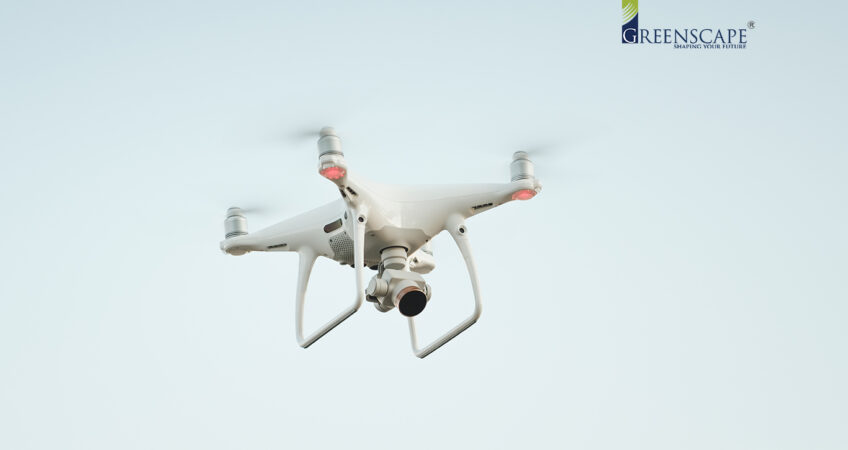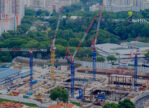Drone Revolution in Real Estate Industry

Drones are quite a rage these days. Whether capturing unique aerial footage or just flying around the town, drones have become the new trend in the construction industry.
The construction industry has transformed into a phase of a revolution where the introduction of drones has impacted the real estate industry towards a whole new level of futurism. The industry is embracing new technologies and takes an effort to deliver results in varied proportions.
Drones have now become the go-to option for many renowned construction companies. Today the industry has experienced a huge growth rate with the implementation of drones. A drone’s data-collecting abilities and aerial vantage point make them an important and useful tool. The photos and videos taken from these drones give a whole new aspect about project information, provide real-time updates and also track the building progress.
As the construction industry evolves and grows, the impact of drones in construction projects will become more beneficial.
HOW DRONES ARE CONTRIBUTING TO THE REAL ESTATE INDUSTRY
Let’s have a quick look at the way drones are used in the real estate sector:
- Land surveys and Topographic mapping:
Topographic maps are needed to execute complex and large-scale construction projects. Though these maps are helpful, they can be quite expensive.
This is where a drone comes to the rescue as it has the benefits of mapping wide quantities of land. Drones can exponentially decrease the time to visualize a site’s topography. Drones will stay on the project’s schedule and match the accuracy levels even before a project has been initiated.
Moreover, the high-resolution images manufactured by drones can be easily transformed into 3D models that help to target challenges during pre-construction and save time and money in the long run.
- Equipment Tracking and Automating:
Handling equipment can be a tedious task for every project manager. When certain equipment goes misplaced, it becomes pretty tricky to find them. However, drones can come in handy for tracking them even within vast projects. The tools, machinery and equipment can be easily misplaced and drones can recognize if certain equipment needs to be terminated to avoid expensive accidental extensive charges.
Equipment malfunctions are also a significant issue in the construction industry. The recording facility in drones can be utilised to access these problems taking place remotely so as to ensure that there is no tampering done.
- Remote monitoring and progress reports:
Monitoring the progress reports remotely is a valuable feature of drones in the construction industry. Drones can provide impressive aerial views and inform clients about the project’s progress, especially when the customers are not available for a site visit.
Adding to the client’s communication aspect, drones can also enhance internal collaboration in your team. A drone can send information directly to your software at a flyover. Designers, construction managers, engineers, workers, and owners can easily access the data anywhere and anytime. Drones can also develop a valuable trail of documents as and when required.
- Security Surveillance:
If a piece of equipment is stolen, it incurs a huge loss since a boom lift or an excavator stolen could mean a loss of thousands. Equipment security is one of the essential aspects that need to be looked upon by construction companies.
To solve this crisis, a drone operator can quickly look at whether the equipment is kept in a secure place or not. The surveillance camera can also be utilised to check if unauthorized individuals are roaming around on the site. These benefits can prevent theft long before it occurs.
- Personnel Safety:
Employee safety is one of the most essential features looked upon by construction organisations. While taking manual measurements, workers often stumble at unsteady heights and stroll through hazardous conditions. Drones come in as your couch of support in these stressful situations. They mitigate the risk that construction organisations face daily.
Construction managers use drone video cameras to monitor the job site for safety concerns. They ensure that the workers are properly balanced with no equipment that tampers the working conditions.
- Structure Inspection and Photography:
Construction companies enjoy the benefits of having photos and videos of their projects from a bird’s eye view. Hence, drones have been very instrumental in helping construction workers.
Due to their manoeuvrability and small size, drones have a unique ability to access views of construction projects that commence from ground level to various heights and viewpoints of the site.
Aerial Images taken by drones help in planning the placement of stored materials, workers’ flow and identifying the potential issues with installed construction packages.
Drones can be used to inspect heavy machinery and bulky scaffolding. They can also be flown over places to check stability and fine details with high-resolution images for analysis.
TYPES OF DRONES AVAILABLE FOR THE CONSTRUCTION INDUSTRY
There are various types of drones and commercial drones which are used in construction. Few models have a fixed-wing, while others have rotating blades. The main difference between the two main drones used for construction companies lies in usage and design. The two major kinds of drones used in construction industries are:
- Fixed-wing drones:
With its aeroplane like design, the fixed-wing drone can easily ride on a set path and reach higher altitudes. These drones look efficient for mapping topography and gliding past surveying distances.
- Rotary Drone:
For closer photography and aerial inspections, the rotary drone is known to be the best option. They are easy to control and can hover over and remain stable at the same time.
Both the fixed and rotary drones are equipped with cameras, thermal sensors, GPS units, and infrared sensors. The collected data from these drones can be sent to a computer through drone software that permits the users to interpret and analyze the data. These characteristics allow the construction projects to be more efficient.
As and when the impact of drones in the construction industry escalates, they are in contention to transform how these construction projects are being handled.
As long as technology passes the zoning hurdles and federal aviation, it is safe to picture drone technology in construction for a longer tenure.



